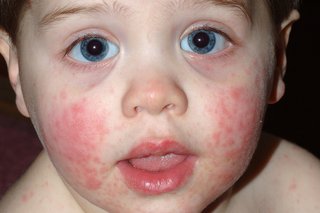This is an air-borne disease and impacts mostly children. A malar rash is a skin outbreak or eruption on the cheeks and the bridge of the nose.

5 Rashes Your Child May Bring Home From Preschool Cleveland Clinic
Slapped cheek syndrome usually gets better on its own within 3 weeks.

Rash on cheeks and nose toddler. Varicella virus which is spread through the air or via direct contact. After another few days a light pink rash may also appear on the chest stomach arms and thighs. Slightly raised pink rashes on the belly chest and back of the body are seen in roseola.
A rash on 1 or both cheeks plus a high temperature runny nose sore throat and headache may be slapped cheek syndrome. Fifth disease causes a bright red rash on the cheeks. If he or she has some fever or achiness.
The pimples look like tiny red bumps. Rashes in kids. Symptoms might include a stuffy or runny nose a sore throat an upset stomach a headache and fatigue.
When the fever subsides kids will usually develop a pink and slightly raised rash on their trunk belly back and chest within 12 or 24 hours of the fever ending. Sometimes a non-blanching rash is really really small only the size of a pin prick called a petechial rash. Childrens paracetamol or ibuprofen can bring down a.
Thats why weve outlined the most common rashes for easy reference. After a few days a rash may appear on their body. Reddish spots with tiny blisters at the centre usually preceded by runny nose cough and mild fever.
If the rash disappears it is blanching good. With so many different types of rashes its tricky to know which is which and how to treat them. Diaper rash Kids health Toddler health.
Fifth disease is a rash that results from a parvovirus B19 infection. Conditions that cause red cheeks in children are. Around 60 of the adults likewise had this disease however they.
If you can still see the rash it is non blanching bad. Viral rashes in young children are common. Slapped cheek syndrome or erythema infectiosum the fifth disease is produced by the parvovirus B19.
All over the body. Its most contagious 24. The rash is red or purple and may be either blotchy or solid in appearance.
Sometimes the child may even have a fever runny nose and cold symptoms. Baby acne usually occurs on the cheeks nose or forehead. Sometimes they have a small white dot in the center a bit like adult acne.
With this skin condition the toddler has bright red cheeks and lacy skin. It is commonly known as a. Check out How to tell if a rash is blanching.
This rash is nothing to worry about. The skin rashes may appear after the fever subsides usually 12 to 24 hours after the fever. You might notice it on the cheeks torso as well as the feet of the toddler.
Other less common symptoms include swollen glands red eyes and diarrhea. After a few days a distinctive bright red rash on both cheeks the so-called slapped cheeks normally appears although adults may not get this. Age 4-8 Chicken pox.
Roseola is not diagnosed until rashes appear and most toddlers are no longer contagious 24 hours after the fever resolves. A viral rash also called a viral exanthem is a rash thats caused by an infection with a virus. By the time this rash develops the condition is no longer contagious.
When the rash shows up usually several days later your childs cheeks will be red and look as if theyve been slapped. Also called slapped cheeks disease or erythema infectiosum this skin condition is common in preschoolers and older toddlers. It is more common in children than adults.
Try using an oral or topical antihistamine to help relieve the itch and keep the rash from getting more angry-looking from your childs scratching. The way to tell if a rash is non blanching is to press a clear glass over it. Most babies I know have experienced it.

What Is Fifth Disease Cleveland Clinic

10 Common Childhood Rashes Baby Gooroo

Cough And Rash Causes Photos And Treatments

Rashes In Babies And Children Nhs

How To Identify Common Childhood Rashes The New York Times

Rashes In Babies And Children Nhs

Childhood Rashes Skin Conditions And Infections Photos Babycentre Uk
